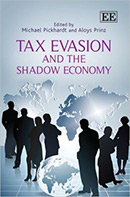Tax Evasion and the Shadow Economy
 Authors: Michael Pickhardt and Aloys Prinz, eds.
Authors: Michael Pickhardt and Aloys Prinz, eds.
Publisher: Cheltenham, UK; Northampton, MA: Edward Elgar Publishing Company, 2012. 200p.
Reviewer: Friedrich Schneider | January 2013
In this book the two editors give in part I a short overview, deal in part II with tax evasion and finally in part III with the shadow economy. With respect to tax evasion, the book adds to the literature by evaluating strategies to fight tax evasion and by examining motivations of individuals for tax evasion. Considering the shadow economy, the book focusses on the impact of the shadow economy on the official economy and an attempt is made to estimate the size of the shadow economy in Europe.
In general this book tackles highly interesting as well as actual research topics, beginning with an overview that surveys the nature of tax evasion and the shadow economy. The three papers dealing with tax evasion in Part II begin with a contribution by James Alm, in which he designs alternative strategies to reduce tax evasion. Alm is a leading scholar in this field and provides a comprehensive survey of the most recent results of theoretical, empirical, experimental and agent based research on tax evasion and tax compliance. In chapter 3, M. Rosaria Marino and Roberta Zizza analyze personal income tax evasion in Italy, and among other things they find that on average over 13.5 percent of net income is evaded. In chapter 4, Gloria Alarcón Garcia, Arielle Beyaert and Laura de Pablos undertake an analysis of female versus male attitudes towards tax evasion in Spain. The authors conducted an empirical study that analyzed the impact of gender, culture and knowledge of the tax code on tax evasion.
In part III, dealing with the shadow economy, Philippe Adair’s contribution is about the extent of the shadow economy in various European countries (concentrating on 15 European Union countries). He presents a comprehensive overview and classification of the diverse forms of shadow economy activities, and he introduces and discusses the different direct and indirect methods to measure the size and scope of a shadow economy. Bogdan Mróz analyzes in chapter 6 shadow economy activities in Poland. He presents an empirical analysis, which is based on survey data that offers some unique insights with respect to the scope of the shadow economy in Poland. He comes to the “usual” result that the bulk of shadow economy employment takes place in three areas: repair, gardening and neighborhood services; together comprising 63 percent. In chapter 7, Miroslava Kostova Karaboytcheva and Luis Rubio Andrada analyze whether the size of a country´s shadow economy and the country´s risk depend on each other. The authors use the Standard & Poor´s risk index to empirically investigate 28 transition and developing countries, and they come to the result that there is a relation between the size of the shadow economy and the country risk index; e.g. the size of the shadow economy in developing countries increases along with the risk of a country. In the final chapter 8, Jürgen Backhaus investigates the Madoff fraud, which is the only contribution dealing with what he calls organized crime and tax fraud. Backhaus comes to the conclusion that the Madoff case seems to be the biggest organized financial fraud in recorded history. He also reaches the rather surprising conclusion that the internal revenue service (IRS) is the biggest winner of this fraud.
In general, this is a highly stimulating book in the area of tax evasion and the shadow economy. It also nicely links the two areas, provides new insights and shows that these two research areas are very lively and bring out really challenging and new results. To everyone who wants to know something about tax evasion and the shadow economy, I can highly recommend this book.
Prof. Dr. Friedrich Schneider
Department of Economics
Johannes Kepler University of Linz
Altenberger Str. 69
A-4040 Linz / Austria


